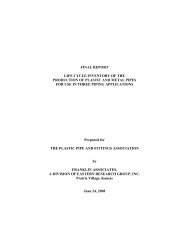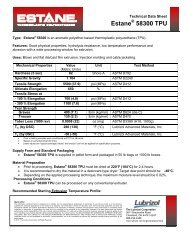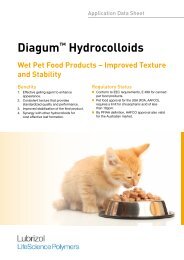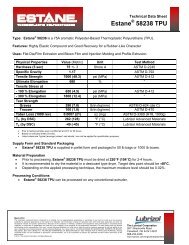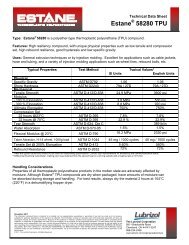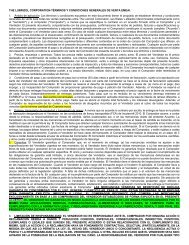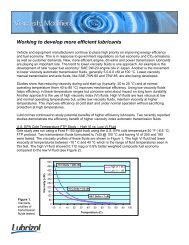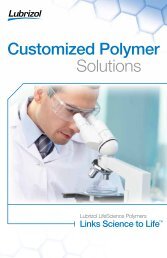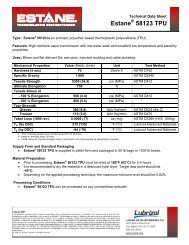Isoplast ® Processing Guidelines - Lubrizol
Isoplast ® Processing Guidelines - Lubrizol
Isoplast ® Processing Guidelines - Lubrizol
You also want an ePaper? Increase the reach of your titles
YUMPU automatically turns print PDFs into web optimized ePapers that Google loves.
<strong>Processing</strong> guidelines
<strong>Processing</strong> guidelines<br />
1 PlasTIc DRYINg FUNDameNTals<br />
Physical nature of water in plastics<br />
Process of drying<br />
1 DRYINg<br />
dryer requirements<br />
Managing residual moisture content<br />
2 DRYeR TechNOlOgY<br />
Principle of dehumidifying/desiccant dryers<br />
regeneration<br />
single/multiple dehumidifying/desiccant bed dryers<br />
return air cooling<br />
dew point meters and calibration<br />
The efficiency of a dehumidifying/desiccant bed<br />
options<br />
4 scRew DesIgN<br />
4 INjecTION mOlDINg<br />
Troubleshooting<br />
Weld line strength<br />
Tool balancing<br />
regrind<br />
Annealing<br />
7 exTRUsION<br />
8 BlOw mOlDINg<br />
8 cOlORINg<br />
These guidelines present information that is common to all forms of processing<br />
for isoPlAsT <strong>®</strong> engineering Thermoplastic Polyurethane resins, followed<br />
by sections specifically for injection molding, extrusion, and blow molding.<br />
The single most important consideration in processing isoPlAsT resins is<br />
drYing! if isoPlAsT resins are not dried correctly before processing, they<br />
will not perform as expected during processing or in the finished parts.<br />
IF YOU DON’T DRY IT…DON’T TRY IT!
PlAsTic drYing<br />
FundAMenTAls<br />
Physical nature of water in plastics<br />
Many plastic resins need to be dried before they are processed.<br />
A moisture content that is too high in molding or extruding can cause<br />
appearance defects such as splay and bubbles on the surface of the<br />
finished parts. in addition to creating an unacceptable part appearance,<br />
water may react with the polymer during processing, reducing the<br />
molecular weight and changing the physical performance of the final part.<br />
Polyamide, polycarbonate, and polyester are examples of resins which<br />
require careful drying prior to processing in order to avoid unwanted<br />
polymer degradation. Thorough drying is a critical requirement for<br />
isoPlAsT resins as well. The resin may suffer a reduction in molecular<br />
weight as a result of processing at a moisture content above the<br />
indicated maximum. isoPlAsT resins can provide the excellent<br />
balance of performance properties for which they are designed,<br />
if they are processed at moisture levels below 0.02 wt% and optimally<br />
below 0.01 wt%. Masterbatch or regrind added to virgin resin must<br />
also meet the same moisture specification (i.e., they must be dried<br />
in the same way as virgin isoPlAsT resins).<br />
Water can collect on the surface of a pellet (adsorption) and/or<br />
diffuse into a pellet (absorption). Absorbed water in particular can<br />
have a significant negative effect on part performance when the<br />
resin is inadequately dried. The more hygroscopic materials absorb<br />
moisture at faster rates and retain it easily, so it is critical to follow<br />
the proper guidelines for drying isoPlAsT resins.<br />
Process of drying<br />
The effective drying of a resin involves two distinct processes:<br />
• The diffusion of moisture from within the pellet to the pellet surface<br />
• The removal of water from the pellet surface<br />
The diffusion of moisture to the polymer surface is facilitated by<br />
elevating the temperature of the pellet. This ensures sufficient mobility<br />
to transport the water to the pellet surface where it is removed by a<br />
continuous air flow that is sufficiently dry (low dew point). This creates an<br />
adequate and steady driving force from the pellet to the air. The rate of<br />
diffusion, and to a lesser extent the amount of water absorbed, determine<br />
the residence time required in the dryer to remove the absorbed moisture.<br />
<strong>Processing</strong> guidelines for isoPlAsT <strong>®</strong> resins<br />
1<br />
drYing<br />
isoPlAsT resins are thermoplastic polyurethane polymers and are<br />
hygroscopic. Because polyurethane polymers absorb moisture, and<br />
react with it at processing temperatures, it is very important to remove<br />
the moisture prior to processing.<br />
Molecular weight reduction and an associated loss of physical<br />
properties are some examples of what can happen if isoPlAsT<br />
engineering thermoplastic polyurethane resins are not dried properly<br />
prior to processing.<br />
we cannot emphasize enough the importance of properly<br />
drying IsOPlasT resins.<br />
isoPlAsT resins that are put into drying hoppers directly from the<br />
sealed shipping containers should typically dry in four to six hours hours<br />
under optimal drying conditions (see dryer requirements). if the seals<br />
on the containers have been broken, or if the resin or regrind has<br />
been exposed to the atmosphere for any reason, the necessary drying<br />
time will be 10 to 12 hours. A moisture level at or below 200 ppm<br />
is necessary for successful processing.<br />
once dry, keeping the resin dry is critical. The ambient air dew point<br />
will have a great effect on how fast isoPlAsT resins pick up moisture<br />
when exposed to the environment. during the summer, when ambient<br />
temperatures and humidity are both high, isoPlAsT resins that have<br />
been properly dried can pick up enough moisture to begin to cause<br />
splay (bubbles and streaking) in as little as 15 minutes!<br />
regrind can be used with isoPlAsT resins at levels up to 25<br />
percent if care is taken to avoid contamination and moisture pickup.<br />
Additionally, parts that are rejected because they were originally<br />
processed when wet cannot be reground and reprocessed. once<br />
the molecular weight of the resin has been degraded by processing<br />
in the presence of moisture, it should be disposed of in an appropriate<br />
manner according to the Msd sheet. if regrind is not used immediately at<br />
the press, it will have to be redried according to the same guidelines as<br />
exposed virgin resin.<br />
The dew point of the air used to dry isoPlAsT resins must be at or below<br />
-40°c (-40°F). if the dryer regenerates based on time rather than dew<br />
point, you must be sure that the dew point does not rise above -40°c<br />
(-40°F) before the dehumidifying/desiccant beds switch for regeneration.<br />
if the dew point does rise above -30°c (-20°F),<br />
the dryer will add moisture to the resin.
drYing (cont.)<br />
Dryer requirements<br />
not every dryer is capable of reducing the moisture level in isoPlAsT<br />
resins to an acceptable level. in general, dehumidifying/desiccant<br />
dryers are suitable for drying isoPlAsT resins, provided they<br />
can produce:<br />
• an air flow minimum of 2.5 m 3/ hr/kg (40 ft3/hr/lb) of material<br />
• a drying temperature between 85°C (185°F) and 138°C (280°F)<br />
dependant on the isoPlAsT resin<br />
• a continuous dry air flow with a dew point of -40°C (-40°F)<br />
which corresponds to 0.008 weight percent moisture in the<br />
dehumidified air<br />
in addition, the hopper must be designed to ensure plug flow so that<br />
all pellets have a similar residence time.<br />
each isoPlAsT resin has a specific drying temperature range and the<br />
drying temperature must be controlled very carefully. The resin itself<br />
must be at the temperature indicated. A substantial amount of heat<br />
can be lost between the dryer control unit and the dryer hopper.<br />
Additionally, if the dryer hopper is not insulated, more heat will be<br />
lost, especially along the outer shell. Therefore, the hopper must be<br />
insulated and the thermocouple that measures the dry air temperature<br />
should be located at the inlet to the drying hopper.<br />
When drying, it is important to keep the air returning to the<br />
dehumidifying/desiccant unit below 55°c (130°F). if the air returning<br />
from the dryer hopper to the dehumidifying/desiccant unit is above<br />
55°c (130°F), the unit cannot remove the moisture from the air.<br />
drying becomes progressively less efficient the hotter the return<br />
air is above 55°c (130°F).<br />
With return air above 65°c (150°F), there will be no drying at all.<br />
Most dryer manufacturers can supply an after-cooler for their drying units<br />
that will cool the return air below the 55°c (130°F) maximum allowable<br />
temperature. As the required drying temperature increases, the need<br />
for an after-cooler also increases.<br />
once dry, it is critical to retain low resin moisture levels during processing.<br />
This can be accomplished by mounting the dryer hopper directly on the<br />
in feed of the processing equipment. Alternatively, a small shot hopper<br />
can be used fed by a closed loop, dry-air conveying system from the large<br />
dryer hopper.<br />
managing residual moisture content<br />
it is prudent to test the dryness of the resin with an air shot. Wet resin<br />
will give an air shot that is foamy and will “pop” as it is extruded from<br />
the nozzle. it will also cause significant nozzle or die drool.<br />
in addition to checking the quality of the melt (must be free of bubbles),<br />
the residual moisture content of the pellets can be measured by a variety<br />
of moisture analyzers. Please contact your preferred equipment provider<br />
for further information.<br />
<strong>Processing</strong> guidelines for isoPlAsT <strong>®</strong> resins<br />
2<br />
drYer TechnologY<br />
Principle of dehumidifying/desiccant dryers<br />
The principle of a dehumidifying/desiccant bed dryer is the closed loop<br />
circulation of heated ‘dry’ air over thermoplastic granules. This releases<br />
moisture into the passing air. ‘Wet’ air subsequently passes through a<br />
dehumidifying/dessicant bed containing a molecular sieve material. This<br />
material is able to absorb the moisture from the circulating air, thus making<br />
it ‘dry’ again (see Figure 1).<br />
After frequent circulation, the dehumidifying/desiccant bed becomes<br />
saturated with moisture and is no longer able to reduce the moisture<br />
in the passing air. To dry the material further, the saturated dehumidifying/<br />
desiccant bed first needs to release its absorbed moisture. This process<br />
of drying a dehumidifying/desiccant bed is called regeneration.<br />
Regeneration<br />
The process of drying a moisture saturated dehumidifying/desiccant<br />
bed is achieved by passing heated ambient air over the bed. The higher<br />
temperature (>200°c [>392°F]) makes the bed release the absorbed<br />
moisture. When the bed is sufficiently dry, it is cooled down and can be<br />
switched back into the closed loop when the alternate bed becomes<br />
saturated with moisture.<br />
Figure 1 – schematic diagram of a 2 dehumidifying/desiccant<br />
bed dryer.
drYer TechnologY (cont.)<br />
single/multiple dehumidifying/desiccant<br />
bed dryers<br />
if the dryer has only one dehumidifying/desiccant bed, the material will not<br />
dry during the regenerating of the moisture saturated bed. To overcome<br />
this time loss, multiple dehumidifying/ desiccant bed dryers were developed.<br />
While the saturated dehumidifying/desiccant bed is regenerating, another<br />
‘dry’ dehumidifying/desiccant bed is switched into the closed loop and<br />
is able to continue drying the material.<br />
To dry isoPlAsT resins sufficiently, multiple dehumidifying/desiccant bed<br />
dryers are preferred because a continuous flow of dry air with sufficiently<br />
low dew point is required. single dehumidifying/desiccant beds tend to<br />
give a larger fluctuation in moisture content in the air. This is not ideal<br />
for drying isoPlAsT resins.<br />
Return air cooling<br />
dehumidifying/desiccant beds have a better moisture absorption<br />
capacity when they remain at a low temperature because more<br />
moisture condenses at a lower temperature (see Figure 2).<br />
Therefore, a return air cooler is sometimes placed between the<br />
material hopper and the dehumidifying/desiccant bed to reduce<br />
the temperature of the hot returning air. The presence of a return<br />
air cooler is recommended for drying isoPlAsT resins.<br />
Figure 2 – an illustration of the dependency of the dry air dew point<br />
on the return air and dehumidifying/desiccant bed temperature.<br />
Dew point meters and calibration<br />
The specification of a dryer will give an indication of the lowest<br />
possible dew point it can reach when in its optimum state. if the<br />
dew point is approximately -40°c (-40°F), the dryer will most likely<br />
be able to dry isoPlAsT resins.<br />
The accuracy of a dew point measurement goes down with time<br />
rather rapidly. dew point meters need calibration frequently, especially<br />
when used continuously. deviations are counter to what actually happens<br />
(i.e., the measured dew point readings appear to become lower with time).<br />
in reality, as the desiccant gets older, its efficiency decreases and the true<br />
dew point rises (see Figure 3).<br />
<strong>Processing</strong> guidelines for isoPlAsT <strong>®</strong> resins<br />
3<br />
Figure 3 – an example of the discrepancy between the actual dew<br />
point of the dryer and the ‘measured’ dew point over time.<br />
To ensure accuracy from your permanently connected dew point meter,<br />
disconnect it from the dryer, and expose the sensor to the ambient air.<br />
This prevents the sensor from drying out, which causes inaccuracy.<br />
refer to manufacturer recommendations.<br />
The efficiency of a dehumidifying/<br />
desiccant bed<br />
if the dryer has been in use continuously for more than three years, or an<br />
equivalent period intermittently, some degradation of the molecularsieve<br />
in the dehumidifying/desiccant beds may have taken place. The dryer may<br />
no longer be able to reach the initial specified dew point. The best way<br />
of establishing whether there has been a serious deterioration of the<br />
moisture absorption capacity of the dehumidifying/desiccant beds,<br />
is to calibrate the dryer on a regular basis with an external calibrated<br />
dew point meter.<br />
location of the dew point meter is important. An internal or<br />
external dew point meter should measure samples from the air inlet to<br />
the drying hopper; in order to provide the best indication of equipment<br />
performance. A dew point meter will help detect any malfunction of the<br />
drying system prior to processing.<br />
All drying systems should be “predried.” By running the system one full<br />
cycle prior to loading, the system will come to the necessary operating<br />
temperature. This will ensure the dew point in the drying hopper is -40°c<br />
(-40°F) before the isoPlAsT engineering thermoplastic polyurethane<br />
resins are placed in the hopper.<br />
Options<br />
isoPlAsT resins have also been dried in vacuum ovens and in microwave<br />
dryers. The drying temperature table still applies, as do the drying times.<br />
isoPlAsT resins will not dry in dryers that use ambient air, whether it is<br />
heated or not.
screW design<br />
nearly all types of processing equipment for thermoplastics use some<br />
form of a plasticating screw device. extrusion, injection molding, and blow<br />
molding equipment all use plasticizing screws. The design of the screw<br />
is very important to the satisfactory performance of the processing<br />
equipment.<br />
A properly designed screw will melt the resin and yield a uniform melt<br />
temperature in the proper temperature range, without over shearing<br />
the resin and causing it to degrade. every resin family has different<br />
requirements for the screws that can be used to process it.<br />
isoPlAsT resins require a screw with a moderate compression ratio<br />
(between 2.0:1 and 2.5:1) and a low “compression rate.” compression<br />
rate is defined as the difference between the in feed zone flight depth<br />
and the metering zone flight depth divided by the number of flight<br />
turns in the compression zone. The compression rate should be between<br />
0.5 to 1.25 mm/turn (0.02 to 0.05 in/ turn) for processing isoPlAsT<br />
resins. The drawing below helps explain how the “compression rate” is<br />
calculated. This definition only applies to a so called “general purpose”<br />
screw. This is a screw with a single flight throughout its length and a<br />
relatively long compression zone. The transition or compression zone<br />
should be about 7 flights for a screw with a 20:1 l/d (length to diameter<br />
ratio). higher compression rates will cause too much shear heating and<br />
melt temperature will be uncontrollable at reasonable production rates<br />
(see Figure 4).<br />
Barrier and mixing screws have been used successfully, but due<br />
to the large number of potential designs, no specific details can be<br />
recommended. Please refer to your technical service and development<br />
representative for assistance. in general, barrier and mixing screws<br />
should be “low shear” or “gentle” in nature. in some cases, screws<br />
designed for rigid PVc have worked well for isoPlAsT resins.<br />
Figure 4 – Injection molding machine screw configuration.<br />
<strong>Processing</strong> guidelines for isoPlAsT <strong>®</strong> resins<br />
4<br />
injecTion Molding<br />
drying is the most important consideration when processing isoPlAsT<br />
resins. Please review the section on drying for important details.<br />
in general, isoPlAsT resins mold best at low melt temperatures, low<br />
injection pressures, and very low injection speeds. The suggested melt<br />
temperature and injection pressures are for parts that are relatively simple<br />
and have typical wall thicknesses. More complex parts or those with thinner<br />
walls will require higher melt temperatures and injection pressures.<br />
injection pressures (hydraulic) often run in the range of 40-70 bar<br />
(600-1,000 psi), with injection speeds in the range of 13-40 mm/sec<br />
(0.5-1.6 in/sec). Packing, or second stage pressures usually run in the<br />
35-55 bar (500-800 psi) range. Higher pressures and speeds may be<br />
needed in more complex parts. running an injection speed that is too fast<br />
will result in brittle parts and splay caused by high shear. This can result<br />
in the “melt fracture” of the parts. Melt fracture usually shows up as a<br />
series of weld lines in a chevron pattern, but can take other forms known<br />
as “flow lines.”<br />
reciprocating screw type injection molding machines are recommended<br />
for molding isoPlAsT resins. Plunger or ram type machines are not<br />
recommended.<br />
do not leave the barrel and screw full of isoPlAsT resins during<br />
prolonged shut downs. Always shut off the in feed throat and empty<br />
the screw before leaving the machine idle for more than 15 minutes,<br />
especially at processing temperatures. in the case of the long glass fiber<br />
filled resins, never leave the barrel full during a shut down. The resin can<br />
evaporate, leaving the barrel full of glass fiber only. This would require<br />
pulling the screw to clean it.<br />
Purging can be done with polystyrene (gPPs or hiPs), sAn, or ABs. We<br />
do not recommend polyolefins, as they are not compatible with isoPlAsT<br />
resins. They will take a very long time to purge out. do not use cellulosic or<br />
polyamide resins to purge isoPlAsT resins. isoPlAsT resins will react with<br />
these, resulting in a cross-linked material that is no longer thermoplastic<br />
(i.e., you will have to pull the screw to clean it).<br />
Besides the specific screw design recommendations given above, we<br />
suggest that injection molding machines for processing isoPlAsT resins<br />
should have an l/d ratio (length of screw to diameter of screw) of at least<br />
20:1. The check valve selection is also very important. ring check valves<br />
are preferred over ball type valves. in addition, the check valve should<br />
have streamlined flow channels but should not be too open. isoPlAsT<br />
melt can be pumped out of the screw more quickly than it can be replaced.<br />
This situation can cause a vacuum void in the screw, stopping the screw<br />
from returning (retracting) until the void is filled. This will cause gassing<br />
in the next shot. if the screw is not returning smoothly and consistently,<br />
a more restrictive check valve may be needed.
injecTion Molding (cont.)<br />
Barrel capacity should be no more than six times the shot size (shot<br />
size should not be less than 15 percent nor greater than 85 percent<br />
of barrel capacity). if the shot size is too large for the machine, the<br />
melt temperature will not be uniform. if the shot size is too small for<br />
the machine, isoPlAsT resins are more likely to degrade. degradation<br />
will start to show up as a yellow color shift and move to splay and<br />
gassing in more extreme cases.<br />
injection molding machine clamping capability should allow for 0.3 to 0.7<br />
metric tones/square centimeter ( 2 to 5 tons/square inch) of clamping<br />
force based on the projected area of the part to be molded. general<br />
purpose nozzles are recommended, rather than nylon type. The orifice<br />
in the nozzle tip should be as big a diameter as possible, based on<br />
the sprue diameter. Variac temperature control is not recommended.<br />
A thermocouple and temperature controller should be used on the<br />
nozzle and tip. isoPlAsT resins tend to freeze off easily at the nozzle<br />
tip, therefore, good temperature control is necessary. it may also be<br />
necessary to insulate the nozzle tip from the sprue bushing. cardboard<br />
can be used to do this. sprue break, or pulling the nozzle tip away<br />
from the mold after the screw has returned (recovered) can allow<br />
the nozzle temperature to recover between shots.<br />
gate sizes should be at least equivalent to a 2.5 mm (0.10 in) diameter<br />
round gate, except in the case of very small components. larger gates<br />
are usually better. submarine gates can be used in some cases with ‘neat’<br />
resins, but with long glass fiber resins, high shear rates through the gate<br />
may result in splay and fiber length reduction. Additionally, early gate<br />
freeze off can cause sinks.<br />
isoPlAsT resins normally do not exhibit excessive sink. if the gate is<br />
large enough to allow fully packing the part before it freezes off, there<br />
will be little or no sinking or internal voids in the parts.<br />
Programmable injection velocity can be a big help in molding isoPlAsT<br />
resins. in cases where gate blush is a problem, it can often be solved<br />
by slowing down the injection velocity until the flow front has just passed<br />
the gate and then subsequently speeding it up to more normal rates.<br />
sometimes minor splay and weld line problems can be controlled by<br />
changing the injection velocity, either up or down. different molds will<br />
require different solutions.<br />
The melt should have the consistency of honey, with few to no bubbles.<br />
There should also be no nozzle drooling. under no circumstances should<br />
the melt temperature exceed 270°C (518°F) and preferably not above<br />
260°c (500°F).<br />
These are recommendations for average set ups with screws that meet<br />
the screw specifications listed above. The temperature profiles may need<br />
to be adjusted for any given machine/mold set up.<br />
some general guidelines are discussed below to help guide changes<br />
that might be needed to compensate for a screw that is not optimal for<br />
isoPlAsT resins.<br />
<strong>Processing</strong> guidelines for isoPlAsT <strong>®</strong> resins<br />
5<br />
To keep shear history to a minimum, run the screw at as low a speed<br />
as is possible while still allowing it to recover in the required cycle time.<br />
Back pressure can be used at levels up to about 14 bar (200 psi). Back<br />
pressure can help with color mixing, melt temperature uniformity, and in<br />
controlling minor splay problems. long glass fiber reinforced isoPlAsT<br />
resins require some back pressure, otherwise the screw will retract without<br />
plasticizing the pellets. This will yield short shots and/or unmelted pellets<br />
in the melt. however, as a general rule, back pressure should be kept as<br />
low as possible.<br />
Vented barrels are not recommended for the isoPlAsT resins because<br />
it is difficult to keep the isoPlAsT resins from foaming out of the vent.<br />
Vented barrels are noT a substitute for drying isoPlAsT resins. By the<br />
time the melt reaches the vent, damage to the molecular weight has<br />
already occurred.<br />
it is a good practice to use “position transfer”, or changing from first stage<br />
injection pressure to second stage injection pressure by screw position<br />
rather than time. This ensures that the injection stroke does not bottom<br />
out and over fill the cavity before packing or the second stage takes place.<br />
To determine the proper position for switch over, short shoot the mold using<br />
only the first stage, filling pressure, and no second stage packing. gradually<br />
change the switch over position until the cavity is 95 – 99% full on first<br />
stage, this will be the proper switch over position.<br />
over packing the cavity on first stage pressure can cause clear isoplast<br />
resins to become brittle. To determine whether brittleness was caused<br />
by over packing or by moisture, anneal the parts for 2 – 4 hours at the<br />
appropriate temperatures shown in Table 1. if they were over packed, the<br />
parts will become ductile after annealing. if the material was process wet,<br />
the parts will remain brittle.<br />
Table 1 – Recommended annealing Temperatures for IsOPlasT Resins<br />
(anneal for 2-4 hours in hot air Oven)<br />
isoPlAsT resin TeMPerATure °c rAnge °F<br />
101 81-89 178-192<br />
202eZ 124-135 255-275<br />
301 101-109 214-225<br />
302eZ 124-135 255-275<br />
101lgF40 & 60 81-89 178-192<br />
202lgF40 124-135 255-275<br />
2510 81-89 178-192<br />
2530 81-89 178-192<br />
2531 101-109 214-225<br />
2540 81-89 178-192<br />
2560 81-89 178-192
injecTion Molding (cont.)<br />
With the long glass fiber filled resins, early position transfer will<br />
cause an artificial weld line. The interrupted flow will result in an area<br />
in the part that is low in glass fiber, creating a weak spot. Position transfer<br />
is still a good idea, but make sure the part is 95 percent full before this<br />
takes place. generally, with long glass fiber filled resins, faster filling will<br />
give stronger weld lines and better surface finish, but excessive speed<br />
will cause jetting into the cavity and may contribute to brittleness.<br />
isoPlAsT resins are sensitive to mold temperature. if the mold is too<br />
cold, there will be low molecular weight on the surface of the finished part.<br />
if the mold is too hot, cycle time will be too long. do not run the mold<br />
temperatures higher than the annealing temperatures shown previously<br />
in Table 1. if parts of the mold surface, such as small core pins, are not<br />
cooled well, they will heat up and the isoPlAsT resin may begin to stick<br />
to the mold surface. uniform mold temperature is very important.<br />
cooling time will run between 10-40 seconds for parts with wall<br />
thicknesses of 1.3-3.2 m (0.051-0.126 in). Thicker parts will<br />
require longer cooling times. The long glass fiber filled isoPlAsT<br />
composites must be cooled until a rigid skin has formed on the outside<br />
of the part. if these composites are removed from the mold too quickly,<br />
they will “post mold blow” (i.e., they will puff up and warp as the hot<br />
plastic allows the long glass fibers to try to straighten out). The only<br />
cure is more cooling, with either more time, a colder mold, or both.<br />
isoPlAsT resins will exactly reproduce the mold surface. if you<br />
need a glossy surface, the mold will have to be finished to at least<br />
an iso 1302 n-1 (sPe #2) finish. Matte finishes are reproduced<br />
from mold surfaces very well.<br />
generally, isoPlAsT resins release easily from molds. if necessary for<br />
a specific part, standard mold release agents may be used (including<br />
silicone mold release), providing the parts are not intended for subsequent<br />
painting, plating, or printing. stearate based mold release agents should<br />
noT be used with isoPlAsT resins under any circumstances. This will<br />
drastically reduce part performance.<br />
Troubleshooting<br />
some problems to look for during molding include runaway temperature<br />
zones and screws that do not return smoothly and consistently. in the<br />
case of runaway temperature zones, turn up the temperature of the zone<br />
just before the problem zone. This symptom is an indication that the resin<br />
is being over sheared in the runaway zone and needs to be pre-heated<br />
more before entering that zone.<br />
it may be necessary to go to a “reverse” temperature profile in some<br />
cases to compensate for less than ideal screw geometry. A “reverse”<br />
temperature profile is defined as one in which the temperature of the<br />
in feed zone is the highest and the zone at the nozzle end is the lowest.<br />
This type of profile will help pre-heat the resin before it enters the<br />
compression zone of the screw, lowering the viscosity and the power<br />
requirement to convey the resin forward.<br />
<strong>Processing</strong> guidelines for isoPlAsT <strong>®</strong> resins<br />
6<br />
it is recommended that there be no water cooling on the feed throat of the<br />
molding machine. The resin must be pre-heated in the dryer. cooling the<br />
resin down and then heating it again in the screw is counterproductive.<br />
Bridging in the feed throat is not normally a problem with isoPlAsT resins,<br />
if they have been dried at the recommended conditions.<br />
The problem of screw stall and/or inconsistent screw return usually<br />
will accompany a runaway temperature zone, but not always. The<br />
problem is that the resin viscosity is too high at some point in the screw,<br />
usually entering the compression zone. The solution is to raise the zone<br />
temperature just before that spot. one way to locate the spot is by finding<br />
the difference between the zone temperature set point and the actual<br />
zone temperature. When this difference is more than approximately 10°c<br />
(18°F), the set point of the preceding zone should be turned up until the<br />
difference disappears.<br />
When the screw stalls (turns, but does not retract), melted resin pumps<br />
out of the screw faster than the unmelted pellets can be conveyed forward.<br />
This creates a void in the screw and the next shot will be gassy. rather<br />
than using temperatures, a second method of correcting this problem is<br />
to use a more restrictive check valve. it will need to be streamlined, but<br />
the flow path must be more restrictive to reduce the pumping rate of the<br />
melted polymer.<br />
if the compression ratio or compression rate of the screw is too great,<br />
the problem may not be solvable with temperature zone control. in these<br />
cases, a new screw will be needed.<br />
weld line strength<br />
Weld lines, the hair lines formed by two or more flow fronts coming<br />
together, always form behind holes in parts. This often occurs around any<br />
obstruction or easy flow channel in the flow path. Weld lines can be strong<br />
with isoPlAsT resins. The melt temperature must be kept high until the<br />
two flow fronts meet. There can be no gas trapping at the flow fronts. if<br />
there are problems, changing the injection speed up or down will usually<br />
move the point at which the flow fronts meet, allowing better ventilation.<br />
if the location of the weld line is constantly moving from part to part, it<br />
is a good indication that the melt temperature is not uniform from shot<br />
to shot. slow the screw speed down as much as possible and raise the<br />
back pressure to help make the melt temperature more uniform. Minor<br />
melt temperature changes will cause significant viscosity changes in<br />
isoPlAsT resins.
injecTion Molding (cont.)<br />
Tool balancing<br />
isoPlAsT resins are very sensitive to over packing in unbalanced tools.<br />
Family molds, molds with dissimilar parts that are molded together, are not<br />
normally recommended with isoPlAsT resins. if a family mold is required for<br />
any reason, the runner and gate system must be designed for balanced flow<br />
and pressure drop. if one part has significantly lower resistance to flow than<br />
other parts, it will fill first, causing over packing of that cavity and resulting<br />
in brittleness. While that cavity is filling, the gates to the other parts may<br />
freeze off creating short shots or sink. careful balancing of the runners<br />
and gates can often remedy this problem.<br />
Regrind<br />
up to 25 percent of reground isoPlAsT resin can be used. care must be<br />
taken to keep out contamination and to keep the regrind dry. Wet regrind<br />
can cause the same problems as wet virgin isoPlAsT resin. it does not<br />
matter where the moisture came from, the resulting parts will be brittle<br />
with splay and there will be nozzle drool.<br />
annealing<br />
The recommended annealing temperatures for isoPlAsT resins are<br />
shown in Table 2. Parts can be annealed in any air oven that gives uniform<br />
heat and can support the part. heavy parts should be annealed on the<br />
lower side of the temperature range for a longer period of time. small<br />
or thin parts that can support themselves may be annealed at a higher<br />
temperature for a shorter period of time. There may be some yellowing<br />
of the surface, but it will not have an adverse effect on the physical<br />
properties of the final parts.<br />
Table 2 – glass Transition Temperatures (Tg) for IsOPlasT Resins<br />
isoPlAsT resin TeMPerATure °c rAnge °F<br />
101 81-89 178-192<br />
202eZ 124-135 255-275<br />
301 101-109 214-225<br />
302eZ 124-135 255-275<br />
101lgF40 & 60 81-89 178-192<br />
202lgF40 124-135 255-275<br />
2510 81-89 178-192<br />
2530 81-89 178-192<br />
2531 101-109 214-225<br />
2540 81-89 178-192<br />
2560 81-89 178-192<br />
<strong>Processing</strong> guidelines for isoPlAsT <strong>®</strong> resins<br />
7<br />
exTrusion<br />
The single most important factor in successfully extruding<br />
IsOPlasT resins is that they be dry before processing. This also<br />
applies to extrusion operations. (see the section on drying for complete<br />
details.) up to 25 percent regrind can be used, but the same drying<br />
requirements still apply.<br />
The following screw configuration is suggested when extruding isoPlAsT<br />
resins. A length to diameter ratio (l/d) of at least 24:1 is recommended.<br />
compression ratios should be between 2.0:1 and 3.0:1. Below 2.0:1<br />
there will be air entrainment. Above 3.0:1 the melt temperature will<br />
not be controllable. check with your technical service and development<br />
representative for complete details on the best ratio.<br />
if the resin is exposed to too much shear, the melt temperature will be<br />
higher than desired. This will result in very low melt strength and may<br />
also result in foaming, die build up, surface splay, and discoloration<br />
of the extrudate.<br />
if the screw cannot be changed to a low shear profile, pre-heating<br />
the resin will usually help. Also, do not use cooling water on the feed<br />
throat. instead, run the dryer at the upper limit of the recommended<br />
drying temperature range, being careful not to cake the material and<br />
starve feed the extruder. slowing down the screw rpm may also help.<br />
screws designed for rigid PVc have performed well with isoPlAsT resins<br />
in some cases.<br />
The resin should be below its glass transition temperature before it<br />
is exposed to water. see Table 2 for the glass transition temperatures<br />
of isoPlAsT resins. isoPlAsT resins can react with water at elevated<br />
temperatures (above glass transition temperature) and will lower<br />
the molecular weight of the resin and the physical properties of the<br />
resulting product.<br />
it is best to try to reduce the melt temperature as much as possible at<br />
the die. Too high a melt temperature will result in die build up and low<br />
melt strength.
BloW Molding<br />
isoPlAsT resins can be blow molded. injection, continuous extrusion, and<br />
accumulator head blow molding techniques have been used. currently, only<br />
relatively light parisons can be extruded because of the tendency towards<br />
low melt strength and a narrow processing window. Parts up to 1.5 kg (3.3<br />
lbs) have been successfully blow molded to date. check with your technical<br />
service and development representative for more details.<br />
coloring<br />
unfilled isoPlAsT resins are not normally supplied pre-colored (factory<br />
colored). long glass filled resins can be supplied in black or natural only.<br />
We encourage all customers that need colored final parts to use natural<br />
plus color concentrate (in-house coloring).<br />
Please check with your lubrizol sales or Ts&d contact for details<br />
of suitable masterbatches and where they can be obtained.<br />
hAndling considerATions<br />
Material safety data (Msd) sheets for isoPlAsT* engineering thermoplastic polyurethane resins are<br />
available from lubrizol, a business group of lubrizol Advanced Materials, inc. and its subsidiaries.<br />
Msd sheets are provided to help customers satisfy their own handling, safety, and disposal needs,<br />
and those that may be required by locally applicable health and safety regulations, such as oshA<br />
(u.s.A.), MAK (germany), or WhMis (canada). Msd sheets are updated regularly, therefore, please<br />
request and review the most current Msd sheet before handling or using any product.<br />
The following comments are general and apply only to isoPlAsT engineering thermoplastic<br />
polyurethane resins as supplied.<br />
Various additives and processing aids used in fabrication and other materials used in finishing steps<br />
have their own safe use profile and must be investigated separately.<br />
hazards and handling Precautions<br />
This resin contains glass fibers as a reinforcing component.<br />
isoPlAsT engineering thermoplastic polyurethane resins have a very low degree of toxicity and under<br />
normal conditions of use should pose no unusual problems from ingestion, eye, or skin contact.<br />
however, caution is advised when handling, storing, using, or disposing of these resins and good<br />
housekeeping and controlling of dusts are necessary for safe handling of product. Workers should be<br />
protected from the possibility of contact with molten resin during fabrication.<br />
handling and fabrication of plastic resins can result in the generation of vapors and dusts<br />
including small particles of glass fibers. dusts resulting from sawing, filing, and sanding of plastic<br />
parts in post-molding operations may cause irritation to eyes and the upper respiratory tract. in dusty<br />
atmospheres, use an approved dust respirator.<br />
<strong>Processing</strong> guidelines for isoPlAsT <strong>®</strong> resins<br />
8<br />
Pellets or beads may present a slipping hazard. slight itching and irritation may result from skin<br />
contact. repeated exposure to particles generated by grinding glass fiber-reinforced materials may<br />
result in implantation of particles in the skin.<br />
good general ventilation of the polymer processing area is recommended.<br />
<strong>Processing</strong> may release fumes which may include polymer fragments and other decomposition<br />
products. Fumes can be irritating. At temperatures exceeding melt temperature, polymer fragments<br />
can occur. good general ventilation should be sufficient for most conditions. local exhaust ventilation<br />
may be necessary for some operations.<br />
use safety glasses. if there is a potential for exposure to particles which could cause mechanical<br />
injury to the eye, wear chemical goggles. if vapor exposure causes eye discomfort, use a full-face<br />
respirator. no other precautions other than clean body-covering clothing should be needed for<br />
handling isoPlAsT engineering thermoplastic polyurethane resins. use gloves with insulation for<br />
thermal protection, when needed.<br />
combustibility<br />
isoPlAsT engineering thermoplastic polyurethane resins will burn and, once ignited, may burn rapidly<br />
under the right conditions of heat and oxygen supply. do not permit dust to accumulate. dust layers<br />
can be ignited by spontaneous combustion or other ignition sources. When suspended in air, dust<br />
can pose an explosion hazard. dense black smoke is produced when product burns. Toxic fumes are<br />
released in fire situations.<br />
Fire fighters should wear positive-pressure, self contained breathing apparatus and full protective<br />
equipment. Water or water fog are the preferred extinguishing media. Foam, alcohol resistant foam, carbon<br />
dioxide, or dry chemicals may also be used. soak thoroughly with water to cool and prevent re-ignition.<br />
Disposal<br />
do noT duMP inTo AnY seWers, on The ground, or inTo AnY BodY oF WATer. For unused or<br />
uncontaminated material, the preferred options include sending to a licensed recycler, reclaimer,<br />
incinerator, or other thermal destruction device. For used or contaminated material, the disposal<br />
options remain the same although additional evaluation is required (see, for example, in the u.s.A.,<br />
40 cFr, Part 261, “identification and listing of hazardous Waste”). All disposal methods must be in<br />
compliance with Federal, state/Provincial, and local laws and regulations.<br />
As a service to its customers, lubrizol can provide lists of companies which recycle, reprocess, or<br />
manage chemicals or plastics, and companies that manage used drums. contact the nearest lubrizol<br />
customer service center for further details.<br />
environment<br />
generally speaking, in the environment lost pellets are not a problem except under unusual circumstances<br />
— when they enter the marine environment. They are inert and benign in terms of their<br />
physical environmental impact, but if ingested by waterfowl or aquatic life, they may mechanically<br />
cause adverse effects. spills should be minimized and they should be cleaned up when they happen.<br />
Plastics should not be discarded into the ocean or any other body of water.<br />
Product stewardship<br />
lubrizol Advanced Materials, inc. has a fundamental concern for all who make, distribute, and use<br />
its products, and for the environment in which we live. This concern is the basis of our Product<br />
stewardship philosophy, by which we assess the health and environmental information on our<br />
products and then take appropriate steps to protect employee and public health and the environment.<br />
our Product stewardship program rests with every individual involved with lubrizol products from<br />
initial concept and research to the manufacture, sale, distribution, and disposal of each product.<br />
customer Notice<br />
lubrizol encourages its customers and potential users of lubrizol products to review their applications<br />
for such products from the standpoint of human health and environmental quality. To help ensure<br />
that lubrizol products are not used in ways for which they were not intended or tested, lubrizol<br />
personnel will assist customers in dealing with ecological and product safety considerations. Your<br />
lubrizol sales representative can arrange the proper contacts. lubrizol literature, including Material<br />
safety data sheets, should be consulted prior to the use of lubrizol products. These are available<br />
from the nearest lubrizol customer service center.
The information contained herein is believed to be reliable, but no representations,<br />
guarantees or warranties of any kind are made as to its accuracy, suitability<br />
for particular applications or the results to be obtained. The information often<br />
is based on laboratory work with small-scale equipment and does not<br />
necessarily indicate end product performance or reproducibility. Formulations<br />
presented may not have been tested for stability and should be used only as<br />
a suggested starting point. Because of the variations in methods, conditions<br />
and equipment used commercially in processing these materials, no warranties<br />
or guarantees are made as to the suitability of the products for the applications<br />
disclosed. Full-scale testing and end product performance are the responsibility<br />
of the user. <strong>Lubrizol</strong> Advanced Materials, Inc. shall not be liable for and the<br />
customer assumes all risk and liability for any use or handling of any material<br />
<strong>Processing</strong> guidelines<br />
beyond <strong>Lubrizol</strong> Advanced Materials, Inc.’s direct control. The SELLER<br />
MAKES NO WARRANTIES, EXPRESS OR IMPLIED, INCLUDING, BUT NOT<br />
LIMITED TO, THE IMPLIED WARRANTIES OF MERCHANTABILITY AND FITNESS<br />
FOR A PARTICULAR PURPOSE. Nothing contained herein is to be considered<br />
as permission, recommendation, nor as an inducement to practice any patented<br />
invention without permission of the patent owner.<br />
<strong>Lubrizol</strong> Advanced Materials, Inc. / 9911 Brecksville Road, Cleveland, Ohio 44141-3201 / 1.216.447.5000 / www.estane.com<br />
© The <strong>Lubrizol</strong> Corporation 2009, all rights reserved. Printed in U.S.A.<br />
XXXXXXX



